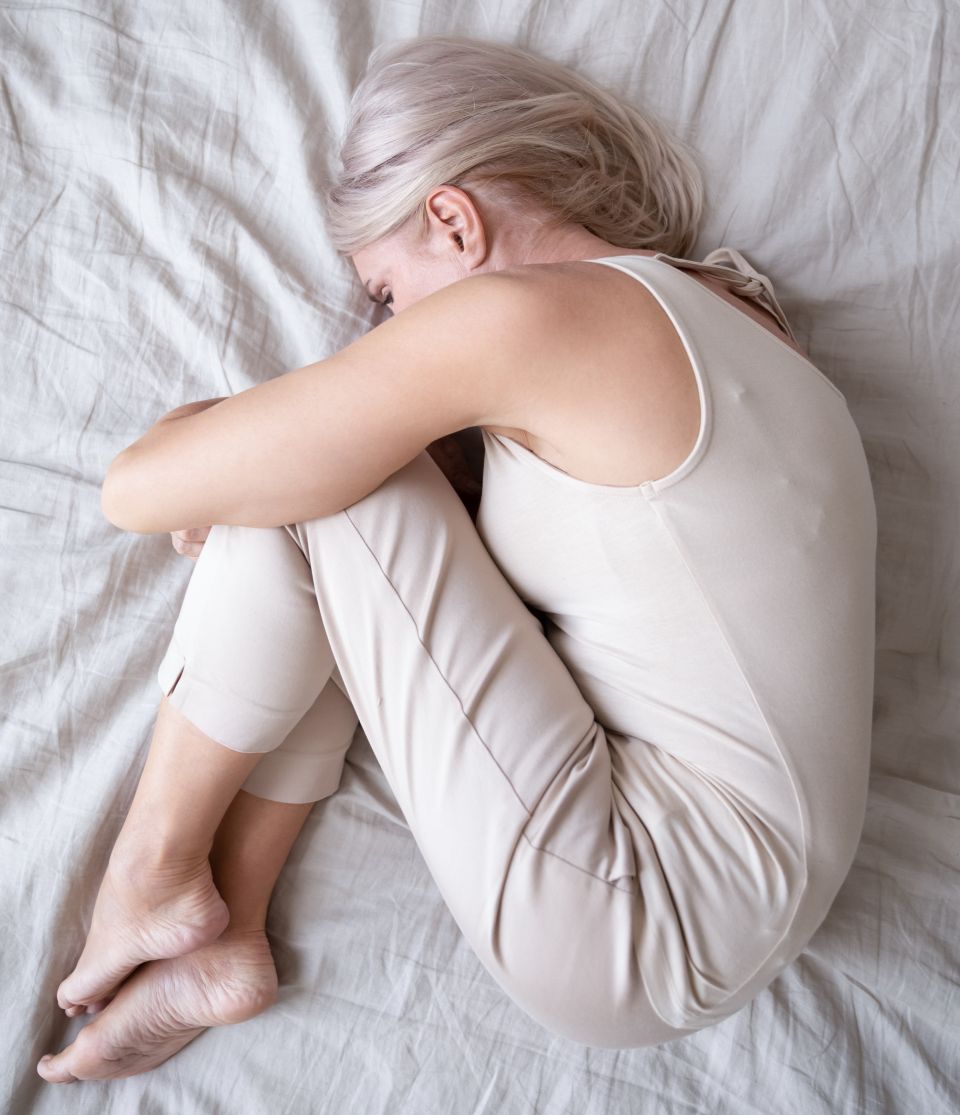How you can influence hormonal balance
Recognizing the signs of menopause
When we’re young, hormones are usually produced like clockwork; this changes as we age, especially for women. Find out how you can detect and effectively offset the first signs of menopause: for better health and well-being in sync with your hormones after 40.

Before we go any deeper: the term “menopause” (also known as the change of life) is not just vague; it’s also laden with prejudices and no longer up to date. It has since been proven that the onset of menopause doesn’t just occur after the age of fifty, therefore affecting only older women. In fact, hormonal changes become noticeable far earlier than that. This has been confirmed by a long-term study carried out on more than 51,000 women from Europe, Asia and Australia, which was published in 2017 in the medical journal Reproduction. The study shows that the age at which girls get their first period is relevant to their onset of the menopause. As such, if a woman’s first period was at the age of eleven or younger, the likelihood of complaints related to hormonal fluctuations occurring before the age of 44 increases by 80 percent.
Although hormone production changes drastically throughout a woman’s lifetime, it does not happen all at once. It takes time for changes in the hormone status to make themselves felt and to make their way into our consciousness in the form of physical or emotional changes. We often only then begin to take action, even though the hormonal changes actually started long before this time. So what might happen if we were to intervene in this process early on and consciously help to shape this transition? As a result, we could continue to enjoy our life and health to the fullest beyond the age of 40. Let us show you how to do this with a few effective tricks.
Hormones up to the age of 40: the carefree time before menopause
Girls are born with more than a million egg cells. From birth, this amount decreases year on year. By the time a girl gets her first period, she has around 300,000 to 400,000 egg cells. During a woman’s lifetime, roughly 500 egg cells reach maturation as part of the menstrual cycle. Under the influence of estrogen, an egg cell begins to mature in a follicle in the ovaries. Ovulation occurs around the 14th day of the cycle. The egg bursts from the follicle and travels through the fallopian tube to the uterus. The follicle left behind in the ovary transforms into a corpus luteum, which now (as well as estrogen) releases the luteal hormone progesterone. Amongst other things, it helps the uterine lining to continue developing and ensures that the fertilized egg cell is able to implant into the uterus. However, if the egg cell remains unfertilized, progesterone levels drop towards the end of the menstrual cycle and the uterine lining is shed during menstruation. This cycle generally follows a very natural course; it is only when something is thrown off balance that we begin to question it and search for causes. When this happens varies from woman to woman: it may occur when switching to hormonal contraceptives or coming off them, or at a later point in time, when the hormonal balance changes naturally as a result of the aging process.
Recognizing the first signs of menopause
Our hormonal cycles are of extremely subtle nature: Even the slightest deviations thus can manifest themselves in our well-being. In this context, it’s not surprising that even minor changes in the balance of sex hormones have a major impact on our mood and health. A crucial component here is cholesterol. It is considered a precursor hormone for all the sex hormones and is formed in the liver. It is required for the gonads to produce sex hormones. In women, these are the ovaries and the hormones estrogen and progesterone, while in men, it’s the testicles and the production of testosterone. Women also produce testosterone, although this takes place to a much lesser extent in the ovaries and adrenal glands.

In order for the ovaries to actually produce estrogen, follicle-stimulating hormone (FSH) is required, which is formed in the pituitary gland. This is also known as the hypophysis and is a roughly pea- to cherry-sized protrusion just beneath the base of the brain or the hypothalamus. FSH stimulates the formation of estrogen, making it both an initiator and a regulator of the female cycle. Estrogen doesn’t just control the female cycle; it also increases the circulation of blood to the uterus, promotes the storage of liquid in the tissue and has a positive effect on bone density and blood lipids, among other things.
The formation of progesterone is also initiated by the pituitary gland. This gland releases luteinizing hormone (LH) from its frontal lobe, which stimulates the production of progesterone in the ovaries. In addition to the development of the uterine lining, progesterone is also important for the immune system, the production of energy, the body’s thermal and water levels and bone and fat metabolism. It also balances out estrogen levels, although it is not capable of developing its full effect without estrogen. Estrogen and progesterone interact closely and depend on each other to work properly. This means that a hormonal imbalance in one area always affects the other area too.
If female hormone levels shift now, the first symptoms may appear as early as the late 30s or early 40s, because the interaction between the pituitary gland and ovaries is no longer optimal, for example. This phase is referred to as the perimenopause. For instance, anovulatory cycles may occur from the age of about 35.
This means ovulation might not occur every month. You might notice this due to experiencing less bleeding than usual. Even though this often goes unnoticed, it has an effect on the hormonal balance, since if an egg is no longer maturing in the follicle, less progesterone is produced, leading to an imbalance in hormone levels.
Other signs of progesterone deficiency may include:
- Premenstrual syndrome (PMS)
- Painful breasts
- Cysts, fibroids
- Insomnia
- Poor circulation
- Acne
- Susceptibility to infection
- Cold hands and feet
- Tendency to bruise
- Moodiness, irritability, overreactions
- Anxiety and depression
The crux of the matter is that very few women (and even attending physicians, both male and female, are not exempt from this problem) in their late 30s or early 40s give any thought to the approaching menopause. Instead, they attribute hormonal changes to other causes.
This phase leads directly to what is known as the perimenopause, which begins on average at about the age of 47.5. This is the main stage of menopause and tends to last many years. During this phase, the ovaries produce significantly less estrogen. This is accompanied by sleep disturbances, irregular cycles, bad mood, joint problems and hot flushes.

Once a woman has had her last period, this is described as the menopause, and only when no further periods have occurred during the following twelve months does the following phase, the “postmenopause”, begin.
As estrogen levels sink over the years, this may manifest itself through the following symptoms:
- Dry skin and mucous membranes
- Outbreaks of sweating
- Increased wrinkles
- Increased appetite and weight gain
- Spotting
- Heart palpitations and irregular heartbeat
- Slowed digestion
- Bone fragility (osteoporosis)
- Decreased libido
- Brittle nails and hair
- Exhaustion
- Forgetfulness
- Depressive moods
How to confidently ride the wave of the hormonal transition after 40
Aftercare is good; preventive care is better. If you are aware of a few key connections between lifestyle and hormone production, you can play a major part in getting through the hormonal changes after 40 in good shape. This can delay or considerably mitigate the first signs of menopause.
Balancing your hormones after 40 by eating right
A good supply of micronutrients is important for maintaining hormonal equilibrium. But the quantity and frequency of food consumption are also of vital importance. These are both essential criteria that are also taken into account in the MAYRLIFE Health Concept. Smaller meals are more easily digestible, and fewer meals distributed throughout the day help relieve the digestive system. In addition, this also promotes the regeneration of the digestive organs, which in turn makes them work more efficiently. This initiates a positive cycle. What’s important here: make sure to not only wait four to five hours between main meals (avoid snacking!), but also allow for a longer period of time between two meals. A good time to observe this practice is overnight. The keyword here is interval fasting, which activates the body’s self-cleaning and repair mechanisms. This allows the digestive organs to fully regenerate, thereby strengthening the immune system.

A pleasant and beneficial side effect of interval fasting is that it is an easy way of reducing and maintaining your weight. This, in turn, has a balancing effect on hormone levels: since estrogen is produced both in the ovaries and in the fatty tissue of the stomach, hips and thighs, shedding even just a few kilograms can get hormone levels back on track.
Furthermore, dietary fiber also aids in breaking down excess estrogen and eliminating it from the body. This is the most important nutritional component for good gut bacteria, which are necessary for digestion to work smoothly. You can counteract any potential constipation, which may occur due to estrogen deficiency.
There is a relatively large amount of fiber in fruit, such as apples, pears, berries and kiwis, vegetables (especially Jerusalem artichoke, potatoes, artichokes and parsnips), wholegrain products, pulses, nuts and seeds. They also contain a whole host of other vital nutrients, such as vitamins, minerals and trace elements and secondary plant substances.
Fermented foods like soy, natural yoghurt, kombucha, kefir, sauerkraut and kimchi also really promote the health of the intestinal flora, the metabolism and also the hormonal equilibrium. They have an antioxidative, anti-inflammatory and detoxifying effect.
How movement and exercise influence menopause
Movement and exercise are like a magic pill for your body: they kickstart and optimize all of the metabolic processes. Furthermore, muscles work as the motor for our limbs, increase our calorie consumption and provide important protection for the joints. Exercise is important for keeping your body, mind and spirit healthy. As we get older, targeted strength training helps prevent age-related muscle loss, which occurs naturally from the age of 30 onwards.
More specifically, those who do not work out lose between 0.3 and 1.3 percent muscle per year – by the time we reach 80, this means an average loss of muscle strength of 40 percent. If we are lacking in these “calorie burners”, the body puts on fat more easily and an imbalance in the hormone levels may occur. However, if you continue to exercise and train your muscles as you grow older, you help your body to metabolize fat, maintain a steady weight and stabilize hormone levels.
Exercise also boosts the production of testosterone, which is important for both men and women when it comes to maintaining a healthy body weight and hormonal balance. Testosterone supports the metabolism of carbohydrates and fats as well as the development of muscle, and plays a crucial role in the storage of fat and how it is distributed throughout the body. Exercise that stimulates the production of testosterone includes intensive strength training, sprints and interval runs.

Gentle methods of movement such as yoga are also incorporated into the programs at MAYRLIFE Medical Health Resort. This boosts the metabolism and also promotes relaxation, slowing down our daily lives and detoxifying the body.
A further aspect of exercise and movement is that they release happiness hormones, most notably serotonin and dopamine. While serotonin is primarily produced in the gut, dopamine is formed in the adrenal medulla and the hypothalamus. Serotonin brightens our mood and makes us feel happy. Dopamine ensures that we get motivated and put our thoughts into action. Both hormones are incredibly important for our health and well-being – especially once the first signs of menopause start to make themselves noticed. Regular physical activity is an effective way to counteract mood swings and ensure a good night’s sleep. This is because the body is able to convert serotonin into melatonin. This takes place in the pineal gland, located at the center of our brain. Melatonin allows us to wind down in the evenings. It’s responsible for making us feel tired and ensuring a good quality of sleep.
Taking control of the symptoms of menopause
A balanced diet (preferably seasonal, regional and organic), regular physical activity and mental equilibrium are the foundations for a life – and hormones – in balance. This is equally important for both men and women. For women aged 35 and over, these factors hold even greater value. They are pivotal in enabling you to deal with and offset the first symptoms of menopause. Armed with the knowledge of the hormonal situation after the age of 40, you can get ahead of the first signs of menopause, take the reins and actively support your health with a balanced lifestyle.
Achieving hormonal balance with MAYRLIFE
A MAYRLIFE treatment course is a meaningful starting point for your new, balanced lifestyle. Our MAYRLIFE experts individually tailor the program, nutrition plan and therapies to suit you, ensuring you receive only what you personally need in order to get back into (hormonal) balance. Get in contact with us, we’ll be happy to advise you!
Sources
Burkhardt Katharina Maria, Friesenbichler Margit, 2021, Tanz der Hormone [Dance of the hormones], 1st edition, Verlagshaus der Ärzte, Vienna
Deutsche Gesellschaft für Innere Medizin e.V. (DGIM), n.p., 27.10.2017, Altersbedingter Muskelabbau wird oft unterschätzt [Age-related muscle loss is often underestimated], accessed 8.2.2022, 18:02
Esche-Belke Susanne, Kirschner-Brouns Suzann, 2020, Midlife Care, Wie wir die Lebensmitte meistern und die Kraft unserer Hormone nutzen [How to master middle age and harness the power of our hormones], lübbe life by Bastei Lübbe AG, Cologne
Awarded 'Best Medical Spa Worldwide'

World Luxury Spa Award 2023
World’s Best Luxury Medical Spa

Seven Stars Luxury Hospitality and Lifestyle Awards 2022
Best Medical Wellness & Longevity Resort

Condé Nast Readers’ Choice Awards 2022
Best Destination Spa

European Health & Spa Award 2024
Best Medical Resort

Haute Grandeur Global Awards 2024
Best Medical Spa in Europe


